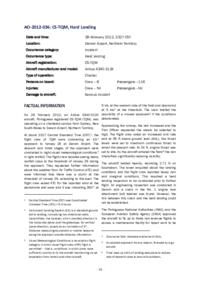
This information is added by users of ASN. Neither ASN nor the Flight Safety Foundation are responsible for the completeness or correctness of this information.
If you feel this information is incomplete or incorrect, you can submit corrected information.
| Date: | Tuesday 28 February 2012 |
| Time: | 23:27 |
| Type: |  Airbus A340-313 |
| Owner/operator: | Hi Fly |
| Registration: | CS-TQM |
| MSN: | 117 |
| Year of manufacture: | 1995 |
| Total airframe hrs: | 40447 hours |
| Cycles: | 9213 flights |
| Engine model: | CFMI CFM56-5C4 |
| Fatalities: | Fatalities: 0 / Occupants: 124 |
| Other fatalities: | 0 |
| Aircraft damage: | Unknown, repaired |
| Category: | Accident |
| Location: | Darwin Airport, NT (DRW/YPDN) -
 Australia Australia
|
| Phase: | Landing |
| Nature: | Passenger - Non-Scheduled/charter/Air Taxi |
| Departure airport: | Sydney-Kingsford Smith International Airport, NSW (SYD/YSSY) |
| Darwin Airport, NT (DRW/YPDN) | |
| Investigating agency: | ATSB |
| Confidence Rating: |
At about 23:27 local time the flight crew of the Airbus A340-313 were conducting an ILS approach to runway 29 at Darwin Airport. The descent and initial stages of the approach were conducted in night visual meteorological conditions in light rainfall. The flight crew recalled seeing heavy rainfall close to the threshold of runway 29 during
the approach. They requested further information about the weather from Air Traffic Control (ATC) and
were informed that there was a storm at the threshold of runway 29, extending to the east. The flight crew asked ATC for the reported wind at the aerodrome and were told it was indicating 360° 5 kts at the western side of the field and downwind at 5 kts at the threshold. The crew briefed the possibility of a missed approach if the conditions
deteriorated.
Approaching the runway, the rain increased and the First Officer requested the wipers be selected to high. The flight crew noted an increased sink rate and at 55 ft above ground level (AGL), the thrust levers were set to maximum continuous thrust to arrest the descent rate. At 34 ft, engine thrust was set to idle. As the aircraft entered the flare the rain intensified, significantly reducing visibility.
The aircraft landed heavily, recording 2.71 G on touchdown. The tower enquired about the landing conditions and the flight crew reported heavy rain and marginal conditions. This required a hard landing inspection to be conducted prior to further flight. An engineering inspection was conducted in Darwin and a crack in the No. 1 engine rear attachment bolt retainer was found. However, the link between this crack and the hard landing could not be established.
A number of components from both main landing gears were also to be replaced as they may have exceeded their design limit.
Accident investigation:
 |
|
Sources:
https://www.atsb.gov.au/sites/default/files/media/3925181/AB2012088.pdf
History of this aircraft
Other occurrences involving this aircraft
| 21 November 2016 | 9H-TQM | Hi Fly Malta | 0 | Amsterdam-Schiphol International Airport (AMS/EHAM) |  |
min |
Revision history:
| Date/time | Contributor | Updates |
|---|---|---|
| 30-May-2024 17:17 | ASN | Added |
| 30-May-2024 17:19 | ASN | Updated [Time, Location, Accident report] |
| 30-May-2024 17:19 | ASN | Updated |
Corrections or additions? ... Edit this accident description
The Aviation Safety Network is an exclusive service provided by:


 ©2024 Flight Safety Foundation
©2024 Flight Safety Foundation